
1301, 1309-17, and 1325 Bagley Street, Detroit.
There is nothing out of the ordinary about these three houses southwest of Bagley and Brooklyn streets in Corktown. They all match the style and the age of the homes around them, each being over a century old.

1301, 1309-17, and 1325 Bagley Street, Detroit.
As it turns out, they have occupied this space for only twenty-eight years. As a creative method of housing infill, the city of Detroit moved these homes from areas where houses were being torn for Tiger Stadium parking in the 1980s. This is how they got there and where they came from.

In this map of Corktown in 1921, green structures are those that are still
standing today, and the blue structures are those that were moved in 1985.
The Bagley Site Before 1985

An aerial view of Bagley and Brooklyn streets, circa 1980.
Photo courtesy of Bruce Beresh and Ben Newman.
The new lots chosen for these houses once contained similar wood-frame houses, but they had been demolished by the 1950s as the neighborhood became increasingly industrialized.
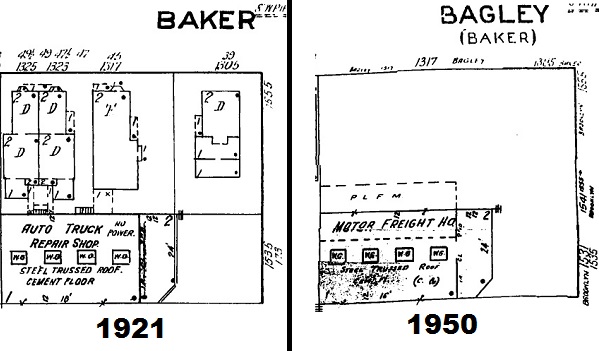
Sanborn maps of Bagley Street, west of Brooklyn, in 1921 and 1950.
The rear of these lots still contained an old freight depot whose address was 1531 Brooklyn Street. This had been a commercial property since the Brooklyn Cartage Company was established here in 1908. In the 1920s, it was the service station for the Detroit branch of the Kelly-Springfield Motor Truck Company. The last business to operate here was Parent Cartage, Ltd. By the 1980s, the building was vacant and owned by the city.

Parent Cartage Ltd. at 1531 Brooklyn Street, 1976.
Image courtesy Michigan State Historic Preservation Office.

Parent Cartage Ltd. at 1531 Brooklyn Street, 1976.
Image courtesy Michigan State Historic Preservation Office.
Not everyone supported the demolition of this building. Some Corktowners wanted it renovated and used as a community center. The conflict resolved itself when the building caught fire and was no longer usable.
The Move

The Buzzard-Kratz duplex, being transported to its new home on Bagley Street.
Source: The Detroit Free Press, July 25, 1985.
The 1985 Corktown House Moving Project was funded by the city of Detroit through a Community Development Block Grant from the U.S. Department of Housing and Urban Development. The city's Community and Economic Development Department reviewed bids and prepared contracts for the job, and coordinated with the Corktown Citizens District Council and the Corktown Non-profit Housing and Development Corporation.

The Sullivan house coming down 12th Street on July 24, 1985.
Image courtesy of the Corktown Citizens District Council.
In addition to the purchase and moving of the houses, the $207,494 cost included a new basement for each house, repair of the old lots, utility hookups, new chimneys, landscaping, and a historically appropriate renovation for each exterior.
The moving and construction were coordinated by the Foremost Development Corporation. Resource Design Group, Inc. was the architect, and the Stanson House Moving Corporation trucked the homes to their new locations. These organizations had to coordinate with the local telephone and electrical companies in order to lift or temporarily reroute utility lines that would have blocked the movers' paths.

Utility lines were moved to accommodate the
Buzzard-Kratz duplex as it headed down Trumbull.
Image courtesy of Amelia Wieske and Paul Royal.
This complex operation had to be scheduled when the Tigers would not be playing at home. The date of July 24, 1985 was chosen, and all three houses were moved on the same day.

Image courtesy of Amelia Wieske and Paul Royal.
Once the old lots were vacated, they were used for Tiger Stadium parking. The Sullivan house on Kaline Drive was donated to the project by Frank and Mary Formosa, who moved to Dearborn in 1981. They retained ownership of the lot, half of which had already been used for parking for many years. The Buzzard-Kratz duplex on Church Street was purchased from Rose Gale, Vince Gale, Joe Gale, and Mary Gale Micallef, who grew up in the home. The lot was among several that they operated as parking lots. The Simpson house on Elizabeth Street was purchased from Irene Sember, who lived next door at 2100 Eighth Street and used several adjacent lots for stadium parking.

The Buzzard-Kratz duplex making a wide right turn onto Michigan Ave. from Tenth St.
Image courtesy of Amelia Wieske and Paul Royal.
Once the exterior renovations were completed, the next step was to find new owners to renovate the interiors. Each home was sold for $6,500 to buyers who could demonstrate that they could complete the job in one year, but it doesn't appear that any of them were finished on time. The first purchasers were Paul and Mary Grima (1301 Bagley), David M. Brown (1309-1317 Bagley), and Gary J. Kaufman (1325 Bagley).
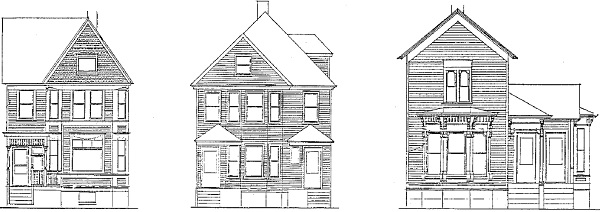
An elevation of what the completed project would look like, circa 1984.
Image courtesy of the Corktown Citizens District Council.
HISTORIES
* * * * *
The Michael & Mary Sullivan House

Original address: 315 Cherry St. (Lot 3, Block 5, Thompson Farm)
Subsequent addresses:
- 1839 Cherry St., following 1921 address change
- 1839 Kaline Drive, following August 2, 1970 renaming after Al Kaline.
Michael Sullivan was born in County Cork, Ireland in December 1847. He immigrated to America at a young age with his parents, Dennis and Catherine Sullivan. Around 1878 he married Mary Evans, born in Michigan in 1858 to Irish immigrants. Michael and Mary Sullivan had at least seven children, whom Michael supported with his work as an iron molder at the Russell Wheel and Foundry Co.
The city issued the building permit for this house to Michael Sullivan on October 29, 1895. The estimated cost to build it was $1,500. Michael and Mary Sullivan would spend the rest of their lives here. Michael passed away June 3, 1920, followed by Mary, who died some time in the late 1920s.
On January 27, 1910, one of the Sullivans' daughters, Lillian (born August 1882), married steamboat captain Frederick Henry Pauls (born June 14, 1884 in Danbury, Ohio). At first Mr. and Mrs. Pauls lived in a home on Ash Street. But since Captain Pauls' work had him away so often, the couple moved in with Lillian's parents. Fred and Lillie Pauls had two children, but neither survived infancy.
From 1911 through 1919, Captain Pauls was the master of the Frank E. Kirby of the Ashley & Dustin line, which ran between Detroit and Sandusky, Ohio daily. The ship was named for her architect, who also designed the Columbia and Ste. Claire (aka the "Bob-Lo Boats").
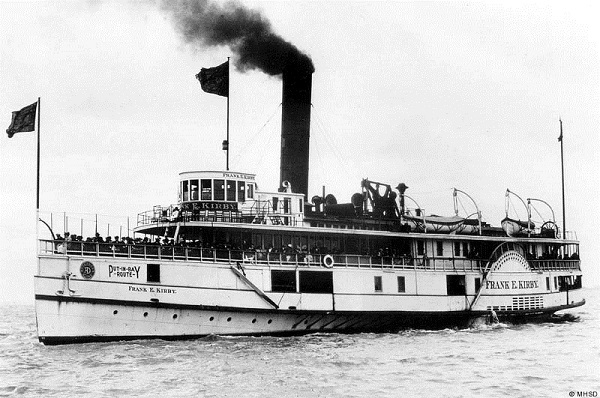
The steamer Frank E. Kirby. (Source.)
After the Frank E. Kirby was sold, Captain Pauls found work on the Mackinac, and ultimately became captain of the brand new Greater Detroit, the largest passenger vessel on the Great Lakes at the time.

The steamer Greater Detroit. (Source.)
In August of 1931, Captain Pauls was removed from command of the Greater Detroit due to a drinking problem. Two weeks later, on September 5th, Pauls' body was discovered in the basement of his home by his brother-in-law, Frank Sullivan. Pauls was found to have committed suicide by wrapping his head in a towel soaked in chloroform. His wife had been away on vacation when the incident occurred.
Mrs. Lillian G. Pauls lived at 1839 Cherry Street--later renamed Kaline Drive--until her death on January 22, 1954.

Mrs. Lillian G. Pauls (1882-1954).
Source: The Detroit News, 5 May 1952

1839 Kaline Drive in its original location in 1976.
Image courtesy of the Michigan State Historic Preservation Office.
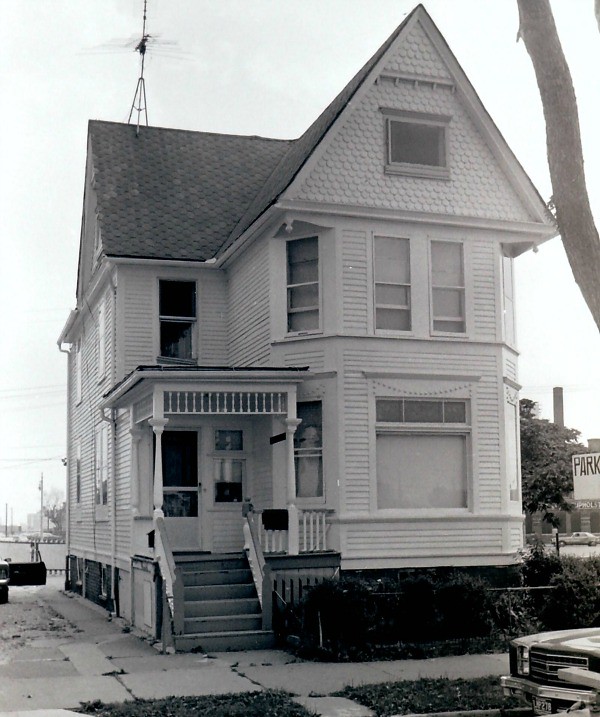
1839 Kaline Drive in its original location in 1976.
Image courtesy of the Michigan State Historic Preservation Office.
The Buzzard-Kratz Duplex

Original address: 54-56 Church St. (Lot 14, Block 82, Woodbridge Farm)
Subsequent address:1610-12 Church St., following 1921 address change
This two-family home appears to have been built around 1905. It came from a lot on Church Street where a previous single-family home was constructed about 1874. Although I have not been able to locate the building permit data, I believe this house is not the same as the one built in 1874 for two reasons: 1) The address 56 Church doesn't appear in the directories until 1906 (prior to that, only 54 Church appears); and 2) The Sanborn maps before and after 1905 clearly show different houses:
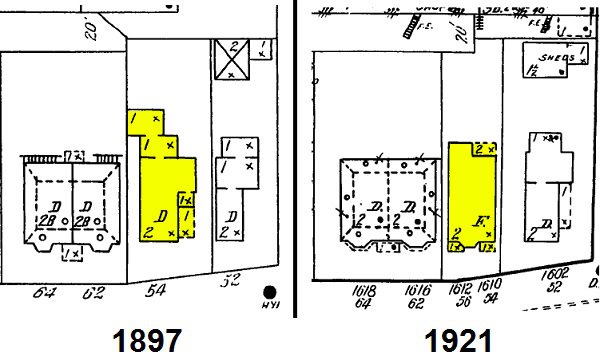
The duplex now faces 180 degrees from its original orientation, so that the lower original address of 54 (1610) Church St. now corresponds to the higher new address of 1317 Bagley, and the higher original address 56 (1612) Church St. address is now the lower new address of 1309 Bagley.
Irvin & Agnes Buzzard
The first occupants of 54 Church Street--the downstairs unit--were Irvin and Agnes Buzzard, first listed at this address in the 1906 directory.
Irvin George Buzzard was born in Groveland Township, Michigan on April 28, 1856. As a young man he worked as an apprentice at the Phoenix Iron Works. Later, he found employment as a marine engineer. On November 17, 1881, he married Agnes Cecelia Gleason. She was born in Michigan in April of 1859. They had two children: Harold G. (1883-1909) and Gleason M. (1898-1979), the latter of whom Mrs. Buzzard birthed at the age of 39.
In December of 1905, Mr. and Mrs. Buzzard co-founded the Jefferson Iron Works Company. Mr. Buzzard was the company's president and manager, and Mrs. Buzzard was vice-president. Their co-founders were Alfred R. Kean (the company's secretary and treasurer) and his wife, Sarah Kean.
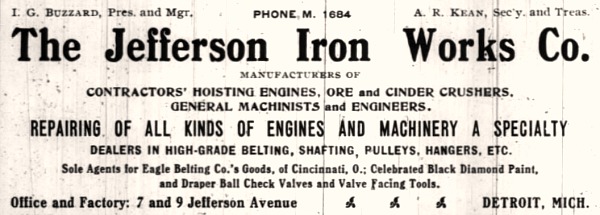
Mr. and Mrs. Buzzard lived in this house only though 1908. By 1909, it was occupied by a postal clerk named Frederick S. De Galan. Irvin Buzzard lived until 1924, and Agnes Buzzard until 1931. Their company still exists, now operating out of Ferndale.
Oscar & Clara Kratz
56 Church Street--now 1309 Bagley, the upstairs unit--was first occupied by Oscar Eugene Kratz and his first wife, Clara. By the time they lived in this house on Church Street, Mr. Kratz was a machine operator for Hamilton Carhartt Inc., which at the time was located directly behind his house. By 1908, he had worked his way up to factory superintendent. Mr. Kratz also designed clothing for Hamilton Carhartt, and his name appears on some of their design patents.

(Source.)
In 1909, Mr. Kratz had become suspicious of his wife and hired a private detective to follow her. He and the detective agreed to meet at a hotel cafe where he would point out his wife. When Mr. Kratz walked in, he found the detective sitting with Mrs. Kratz. "What are you doing with my wife?" he asked, according to a newspaper account of the incident (Detroit Free Press, 23 Mar 1909). The detective had no idea that the woman he was talking to was Mrs. Kratz, who told the detective that she was unmarried. Mr. Kratz obtained a divorce soon after. On November 9th of that same year, Oscar Kratz married Nanno L. Hunt, and they would have at least two children together. Mrs. Nanno Kratz passed away in 1934. In 1941, Oscar Kratz married a third time, to Miss. Ada C. Floyd.
Mr. Kratz lived in the duplex on Church St. through 1908. In 1909, he was listed at an address on Columbia Street.
In 1917, Mr. Kratz left Hamilton Carhartt and moved to Kansas City, Missouri to take up a position with the H. D. Lee Mercantile Company, manufacturers of workers' clothing, known today as Lee Jeans.

(Source.)
Kratz continued to design clothing for Lee, including this jean jacket in the 1940s.

(Source.)
Kratz's jean jacket is now known as the Lee 101-J. It has been called an "archetypal" and "iconic" jean jacket, and is still in production.

(Source.)
Oscar E. Kratz passed away on January 13, 1969 in San Diego, California at the age of 92.

The Buzzard-Kratz duplex in its original location on Church Street in 1976.
Image courtesy of the Michigan State Historic Preservation Office.

The Buzzard-Kratz duplex in its original location on Church Street in 1976.
Image courtesy of the Michigan State Historic Preservation Office.

The Buzzard-Kratz duplex, being escorted down Michigan Ave. on July 24, 1985.
Image courtesy of Amelia Wieske and Paul Royal.
The William T. Simpson House

Original address: 228 Orchard St. (Lot 8, Block 88, Woodbridge Farm)
Subsequent address:
- 412 Elizabeth St., following c. 1912 union of Orchard and Elizabeth streets
- 1360 Elizabeth St., following 1921 address change
William Thomas Simpson purchased the original lot that this house stood on from Samuel Zug on September 25, 1883 for $850. A home first appeared at this address in the city directory in 1884.
Simpson was born in Ontario in January 1839. He moved to Rochester, New York in 1860 where he learned the art of artificial limb making from Dr. Douglas Bly. During the Civil War he moved south in order to supply maimed soldiers with his products. In 1875, Simpson accepted the invitation of James A. Foster of Detroit to join him in the business of artificial limb manufacturing. Foster died in July 1881, leaving Simpson his appointed successor. Simpson's business prospered, filling orders throughout the United States and Canada.
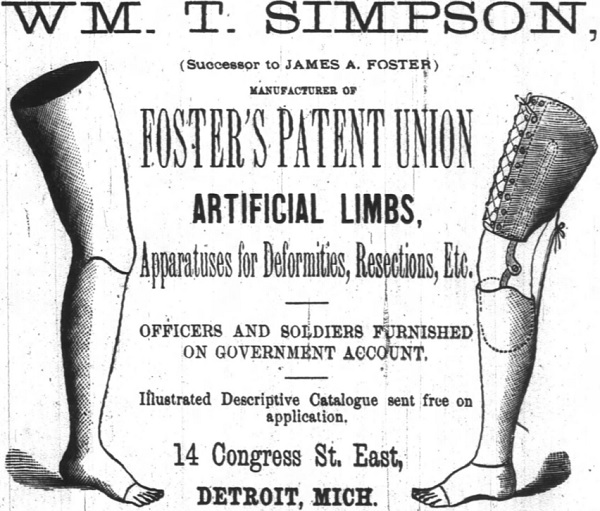
William Simpson's first wife, Lettie Moitmoir Simpson, passed away on February 25, 1893, at the age of 41. Mr. Simpson married again, on October 30, 1894, to Clara Beuttner. Neither of Simpsons' marriages produced any children.

William Thomas Simpson (1839-1915) (Source.)
Mr. Simpson operated his business downtown until 1912, when he moved it to Corktown. The final address of his shop would have corresponded to 1342 Michigan Avenue, a space that is now a vacant lot. He lived in his home on Elizabeth Street until his death on December 27, 1915. Mrs. Clara Simpson subsequently spent the rest of her life in this home, passing away on February 26, 1939.

The Simpson house on cribbing in preparation to be moved.
Image courtesy of the Corktown Citizens District Council.

The Simpson House almost at its new location on Bagley Street.
Image courtesy of the Corktown Citizens District Council.
Although this project was slow to progress through the government's bureaucracy, it was ultimately a success. These homes and their tangible connection to Corktown's history were saved from being destroyed to make room for gravel parking lots. Old houses injected new life into a formerly industrialized block begging to be reactivated as a residential area. In this instance, the taxpayers' money was well-spent.
A project similar to this one would make sense in parts of the city where one can find blocks consisting of only one or two lonely houses. In light of the Corktown relocation project, and the Detroit Future City report calling for the deactivation of under-populated neighborhoods, moving houses out of such areas to more stable communities seems like a superior alternative to demolition, especially if the homes happen to be well-cared for, historic, or architecturally significant.

All three houses just after having been set in their new locations. (Source.)

Amazing post! Corktown has such a broad and wonderful history. Your research is fascinating!
ReplyDeleteI can't believe I have read this whole post - you have captured so many layers of this story - even the suicide of the captain who was relieved of his command of the ship! Truly one of the best blogs I've read!
ReplyDeletethe church was placed on rollers and moved to the former site of these residentces. In the aerial photograph below, the church has advanced into the intersection. online moving quote
ReplyDeleteThanks for your information, it was really very helpfull.. http://www.selfpackremovals.com.au/
ReplyDeleteAwesome article! I want people to know just how good this information is in your article. It’s interesting, compelling content. Your views are much like my own concerning this subject
ReplyDeletehttps://www.lcrenovation.co.uk/
Renovations in Bermondsey
I have seen your writing skills. Your writing skills are very amazing. I really like this article very much and am also very impressed by your writing skills on this article. I think you are a heavy and an old blogger.
ReplyDeleteHome Shifting Service in Rawalpindi
car booking ccompany
ReplyDeleteThis comment has been removed by the author.
ReplyDeletesuch a nice and entertaining stuff for us.Packers and Movers in Islamabad
ReplyDeleteThanks for your great information, the contents are quiet interesting. I will be waiting for your next post,
ReplyDeletePackers and Movers in Karachi
Thank you for being open to sharing information with us
ReplyDeletePackers and Movers in Lahore
We Provide International cargo services in Islamabad
ReplyDeleteThank you for addressing this problem. It’s been a challenge for me, and your advice is gold.
ReplyDeletePackers and Movers in Karachi
This is exactly what I was looking for. Thank you!
ReplyDeletePackers and Movers in Lahore
Most Searches House shifting Company in Islamabad
ReplyDeleteHouse shifting Services in Islamabad
Mahir Packers and Movers is one of the leading moving and packing service providers in Multan, known for offering reliable and efficient relocation solutions.
ReplyDeletePackers and Movers in Multan
Thanks you for this amazing post ..
ReplyDeleteHouse Shifting Services in Islamabad
Good Article. I hope i will read these type of article in future again, being a writer i have to read multiple aritcles on daily basis as i have to work. Packers and Movers in Islamabad
ReplyDeleteGreat Work, Keep Sharing.
ReplyDeletePackers and Movers in Karachi
ReplyDeleteMahir International cargo Services in Islamabad stands out as a premier provider of air and sea freight logistics services, catering to businesses of all sizes.
contact us :03304860000
https://mahirpackers.com
Email:info@mahirpackers.com
House Shifting Services in Islamabad and international cargo services. In an era where convenience and efficiency are paramount, Mahir Packers and Movers in Lahore stands out by using cutting-edge technology and streamlined processes to ensure a hassle-free moving experience.
ReplyDeleteThank you for being open to sharing information with us ..Packers and Movers in Karachi
ReplyDeleteMahir Packers and Movers is the best Packers and Movers in Karachi
ReplyDeletePackers and Movers in Karachi
Good Article. movers and packers in Islamabad
ReplyDeleteThank you for being open to sharing information with us .Packers and Movers in Islamabad
ReplyDeleteThank you for being open to sharing information with us. movers and packers in islamabad
ReplyDelete“Fast, secure, and affordable internaional cargo services in islamabad
ReplyDelete& Rawalpindi. We deliver worldwide by air and sea with trusted handling, on-time shipments, and hassle-free logistics—your goods, our responsibility!”
Looking for dependable
ReplyDeleteinternational cargo services in Islamabad Whether you're shipping personal items or business goods, we offer the most reliable and efficient solutions for all your international shipping
“Reliable International Cargo Service in Rawalpindi. Fast and secure delivery to all countries.”
ReplyDeleteInternational Cargo Services in Lahore
ReplyDeleteare fast and reliable.Safe packing and smooth worldwide delivery every time.
"Best house shifting service in Islamabad— fast, safe and affordable! Packing, loading, moving, everything professional. Call now for tension-free shifting."
ReplyDeletepackers and movers service in islamabad — fast, safe aur reliable! Packing, loading, moving sab professional. Tension-free shifting guaranteed!"
ReplyDeleteInternational Air & Sea Cargo Services in Lahore
ReplyDelete,Safe packing, fast delivery, and hassle-free shipping to all countries. Ship your items worldwide with confidence! 📦✅
International Cargo Service in Islamabad,Get your items safely packed and shipped worldwide with ease. Hassle-free delivery every
ReplyDeleteHome Shifting Services in Islamabad ,Safe packing, careful handling, and timely delivery make your move stress-free. Move your home with confidence! 📦✅
ReplyDeleteComplete House & Office - Home Shifting Services in Islamabad Rawalpindi Lahore Karachi - Pakistan
ReplyDeleteHouse Shifting Services in Islamabad & Relocation Services in Islamabad : 0304-111-1221
Marshall Packers and Movers in Islamabad is your go-to partner for safe, smooth, and budget-friendly house shifting services that make relocation simple and worry-free.
Packers and Movers in Islamabad Great info shared. Very clear and simple!
ReplyDeletePackers and Movers in Islamabad Great info shared. Very clear and simple!
ReplyDeleteMovers and Packers in Pakistan
ReplyDeleteMovers and Packers in Islamabad
global freight forwarding Services in Rawalpandi Helpful post. Straight to the point!
ReplyDeletePackers and Movers
ReplyDeletePackers and Movers in Pakistan
ReplyDeleteglobal freight forwarding
International Cargo Services in Lahore Great info shared. Very clear and simple!
ReplyDeletePacking Solutions for International Shipments
ReplyDeletegoods arrive safely at their destination providers international cargo Services in Islamabad offer a range of packing solutions
global freight forwarding Services in Lahore Good content here. Short and useful!
ReplyDeleteglobal freight forwarding Services in Islamabad Very clear explanation. Thanks for sharing!
ReplyDeleteServices in Karachi Simple and informative. Good job!
ReplyDeleteinternational air cargo Services in Islamabad offering fast, secure shipping, door-to-airport delivery, customs clearance support and worldwide destinations.
ReplyDelete